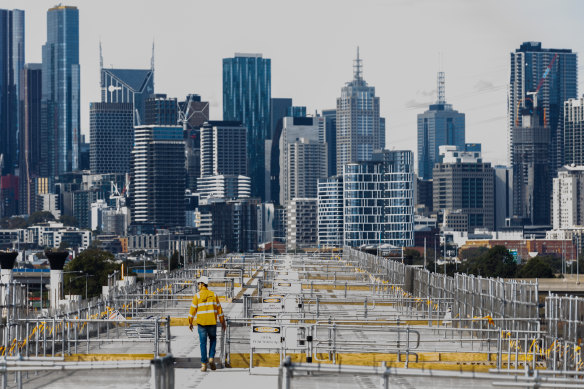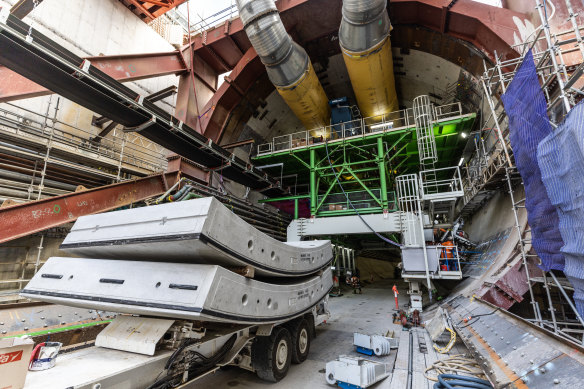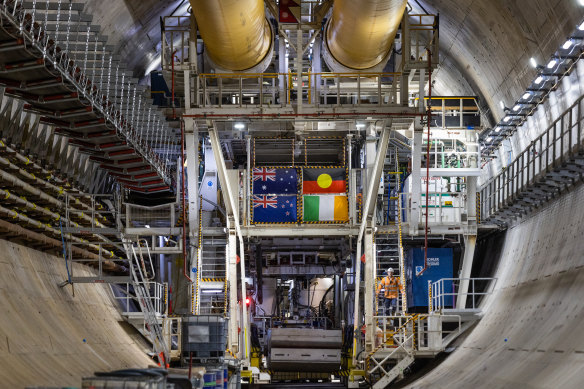- Exclusive
- National
- Victoria
- Infrastructure
This was published 3 years ago
The hole story: New details of West Gate Tunnel progress revealed
By Paul Sakkal
For 1½ years, two gargantuan tunnel-drilling machines have lain dormant just west of Melbourne’s CBD.
After the discovery of toxic soil in 2019, tunnelling was delayed on the city-shaping West Gate Tunnel project. It also put a pause on the frequent press conferences from government politicians in hard hats, as the tunnel linking the West Gate Freeway in Yarraville with CityLink at Docklands became a symbol of Labor’s popular but troubled “Big Build”.
But despite the government considering dumping the builders and finding new ones, the project is back on track after a legal dispute ended in December.

A worker on top of the elevated road that will tower over Footscray Road, connecting the west to the CBD.Credit: Jason South
Photographers have not been on-site since the state government began fighting with the builders over who should pay for cost overruns caused by the toxic soil and what the government claimed was a big underquote from Transurban, which controversially came up with the idea for the tunnel.
Last week, Age photographer Jason South became the first to capture images of progress over the past 18 months: a 500-metre stretch of elevated road that will run 25 metres above Footscray Road, and the dozens of pylons that will hold up this raised section.
For the first time since the project began, two enormous tunnel boring machines are active beneath Yarraville, where they will drill almost seven kilometres of underground road. The tunnelling machine nicknamed Bella has excavated 320 metres in its first month, while counterpart Vida is starting up.

The entrance to one of the tunnels under Yarraville.Credit: Jason South
Other milestones notched since the public were last updated on the tunnel’s progress include widening of the freeway from eight lanes to 12. Almost 80 per cent of the widening works are complete and 60 per cent of the noise-absorbing walls have been built.
The builders believe some sections could be finished quicker than anticipated, potentially bringing the overall completion date forward. The project was originally due to cost $5.5 billion and be completed by 2023; the price tag will be closer to $10 billion and it will finish about 2025 based on current projections. The increased cost will be split about 50-50 between private firms and the government.
The tunnels will begin at the West Gate Freeway and travel under Yarraville before turning into a bridge just before the Maribyrnong River and connecting with major arterial roads in North Melbourne and Docklands.
The intention is to create new entrances from the western suburbs into the CBD, to take pressure off the West Gate Bridge. This crossing carries about 200,000 vehicles per day but frequently turns into a car park when crashes occur.

Tunnelling machines have made progress this year.Credit: Jason South
Corey Hannett, director-general of the Major Transport Infrastructure Authority, said thousands of employees were working day and night on a project that “will not only cut travel times but will make Melbourne’s west an even better place to live”.
The government believes travel times from the west into the city could be reduced by 20 minutes, though some experts have questioned the government’s travel modelling. It is also hoped the tunnel will take 9000 trucks a day off residential streets in the inner west by creating a more direct route to the Port of Melbourne.
Reducing delays for Victorians on roads and public transport – thereby boosting time at home with family and easing stress levels – is the political driver for the government’s massive infrastructure pipeline, which has raised questions from the auditor-general, experts and the opposition about whether the state can afford so many mega-projects.

Flags put up by workers inside one of the new tunnels.Credit: Jason South
And while the project is progressing, it’s not all plain sailing. A union demarcation dispute is frustrating progress and the Construction, Forestry, Maritime, Mining and Energy Union became angry when builders hired a security firm it considers hostile.
Victorian Transport Association chief executive Peter Anderson said the project was needed because freight and truck volumes will double by 2050, necessitating new connections to and from Melbourne’s port and the removal of trucks from local roads.
“This will benefit the industry by better managing the flow of trucks, ensuring safety in the road system and improving productivity and the economy,” said the head of the body that represents transport and logistics companies.
RMIT’s director of urban research Jago Dodson, a critic of the project, said he was concerned it may “pump” 9000 vehicles per day into the CBD. He raised questions about the cost of the tunnel and the government’s transport agenda, which he said was not tied to an overarching strategy complementing the city’s needs.
“I fear if we were to undertake that exercise of accounting for all decisions, we’d find there is not a coherent overall pan, and then we would need to ask questions about the money we are going to spend on these projects,” he said, adding that Transurban being permitted to toll CityLink for another decade cemented the company’s “grip” on Melbourne’s road network.
The Morning Edition newsletter is our guide to the day’s most important and interesting stories, analysis and insights. Sign up here.